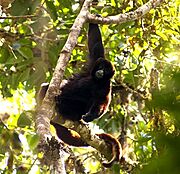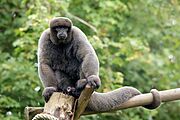Woolly monkey facts for kids
Quick facts for kids Woolly monkeys |
|
|---|---|
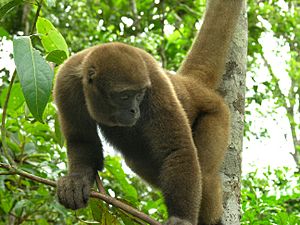 |
|
| Lagothrix lagothricha | |
| Scientific classification |
|
| Kingdom: | Animalia |
| Phylum: | Chordata |
| Class: | Mammalia |
| Order: | Primates |
| Suborder: | Haplorhini |
| Infraorder: | Simiiformes |
| Family: | Atelidae |
| Subfamily: | Atelinae |
| Genus: | Lagothrix É. Geoffroy, 1812 |
| Type species | |
| Lagothrix humboldtii É. Geoffroy, 1812
|
|
| Species | |
Woolly monkeys are amazing New World monkeys found in the rainforests of South America. They belong to a group called Lagothrix. These monkeys are known for their thick, soft fur and their incredible prehensile tails, which act like an extra arm! They live together in big social groups, always exploring their forest homes.
Contents
Meet the Woolly Monkey Family
There are two main types, or species, of woolly monkeys that scientists recognize. These are the Yellow-tailed woolly monkey and the Common woolly monkey. Each species lives in different parts of the South American rainforests.
| Common name | Scientific name and subspecies | Range | Size and ecology | IUCN status and estimated population |
|---|---|---|---|---|
| Yellow-tailed woolly monkey | Lagothrix flavicauda (Humboldt, 1812) |
This monkey lives only in Peru.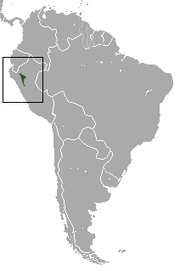 |
Size: Habitat: Diet: |
CR
|
| Common woolly monkey | Lagothrix lagothricha (Humboldt, 1812) Five subspecies
Gray woolly monkey, L. l. cana
Brown woolly monkey, L. l. lagothricha Colombian woolly monkey, L. l. lugens Silvery woolly monkey, L. l. poeppigii Peruvian woolly monkey, L. l. tschudii |
You can find this species across a wider area, from parts of Brazil to Peru, Ecuador, Colombia, and Venezuela.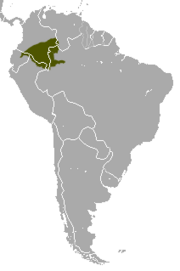 |
Size: Habitat: Diet: |
VU
|
What Do Woolly Monkeys Look Like?
Woolly monkeys are cousins to spider monkeys. They have a thick, soft brown fur coat. Their arms and legs are often dark gray, while their bellies are black. Their heads are usually a lighter brown color. Both male and female woolly monkeys have similar fur colors.
One of their most amazing features is their prehensile tail. This tail is super strong and flexible. They use it like an extra hand to grab branches and climb through the trees. It helps them move around their forest home with ease.
These monkeys are quite large. An adult woolly monkey can weigh about 7 kilograms (15 lb), which is like carrying a big bowling ball! Male woolly monkeys are usually a bit heavier than females, but they are about the same length.
Where Do Woolly Monkeys Live?
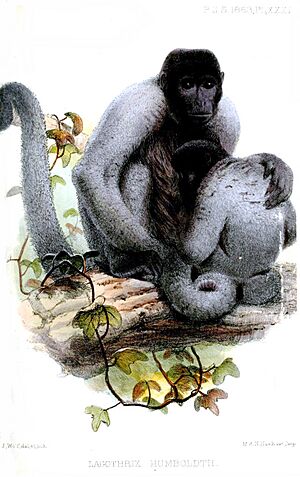
Woolly monkeys make their homes in the northern parts of South America. You can find them in countries like Bolivia, Brazil, Colombia, Ecuador, Venezuela, and Peru.
They are quite adaptable when it comes to their homes, living in various types of forests, including high-elevation cloud forests, seasonally flooded rainforests, and forests in Colombia's eastern plains region. Their ideal habitat, however, is humid, mature tropical forests with tall, ancient trees and rich plant life.
Living in a Group: Social Life
These monkeys are very social animals. They live in groups that can have anywhere from 5 to 45 members! Sometimes, smaller groups of 2 to 6 monkeys will split off to search for food. This helps make sure everyone gets enough to eat without too much competition. An "alpha male" usually leads each big group.
What Do Woolly Monkeys Eat?
Woolly monkeys are mostly fruit-eaters. Their diet mainly consists of delicious fruits they find in the forest. They also enjoy munching on leaves, seeds, and colorful flowers. Sometimes, they will even eat small invertebrates, like insects, for extra protein.
Communication in the Forest
Woolly monkeys are great communicators! They use many different ways to talk to each other. They have a complex system of calls and sounds, like shouting or chattering. They also use smells, body language, and touch to share messages. This helps them work together, show if they are happy or upset, and even mark their territory. Playing together is also important for them. It helps them build strong friendships and figure out who is in charge within the group.
Reproduction and Family Life
In woolly monkey groups, both males and females have several partners. This helps keep their population healthy. When young females grow up, they often move to a new group. This prevents them from having babies with close family members. Male monkeys, however, usually stay with the group they were born into. This way, new families are formed, and the woolly monkey population continues to thrive.
Protecting Woolly Monkeys
Woolly monkeys face dangers from several predators in the wild. Large birds like eagles and powerful cats such as the jaguar sometimes hunt them. Sadly, their biggest threat comes from humans. People have hunted these monkeys for food and for the illegal pet trade.
Another big problem is that their forest homes are shrinking. This is called habitat loss. All these challenges have caused the number of woolly monkeys to drop. Because of this, woolly monkeys are now considered an endangered species.
To help protect them, there are special programs, like the International Breeding Program for Endangered Species. In these programs, woolly monkeys are cared for and bred in zoos or special centers. This helps ensure that these amazing animals will continue to exist for future generations.
Interesting Facts About Woolly Monkeys
- Woolly monkeys are part of the "New World" monkey group, which means they are native to Central and South America. These monkeys have some distinct features compared to "Old World" monkeys (from Africa and Asia), such as typically having flatter noses with nostrils that face sideways.
- They share a close evolutionary relationship with spider monkeys, another type of Atelidae monkey known for its long limbs and prehensile tail.
- By eating a lot of fruit, woolly monkeys play a vital role in the rainforest ecosystem. When they digest the fruit and move around, they disperse seeds through their droppings, helping new trees and plants to grow and keeping the forest healthy and diverse.
- In captivity, woolly monkeys can live for quite a long time, sometimes over 20 years!
- Their love for play isn't just for fun; it's a crucial part of their social development, helping them learn social rules and strengthen relationships within their group.
See also
 In Spanish: Lagothrix para niños
In Spanish: Lagothrix para niños


